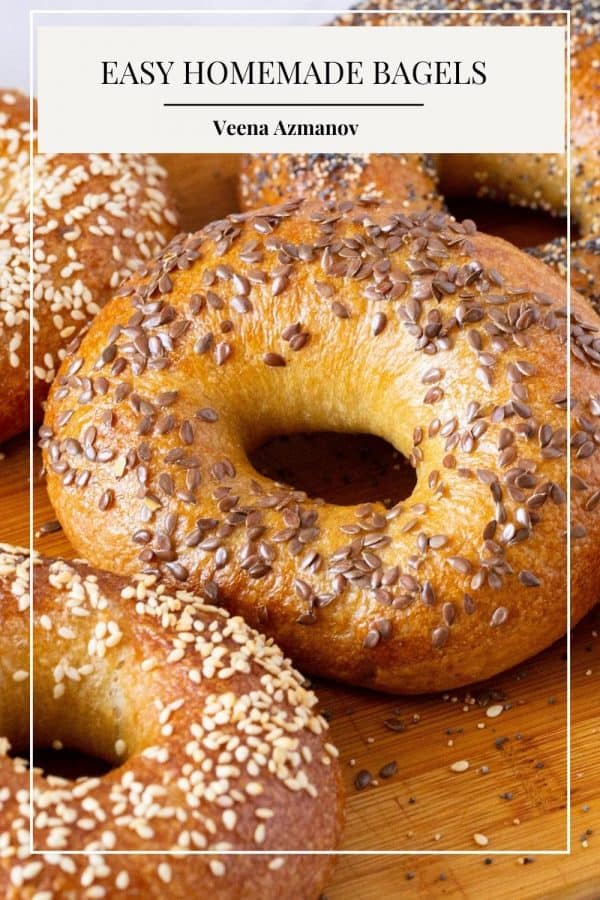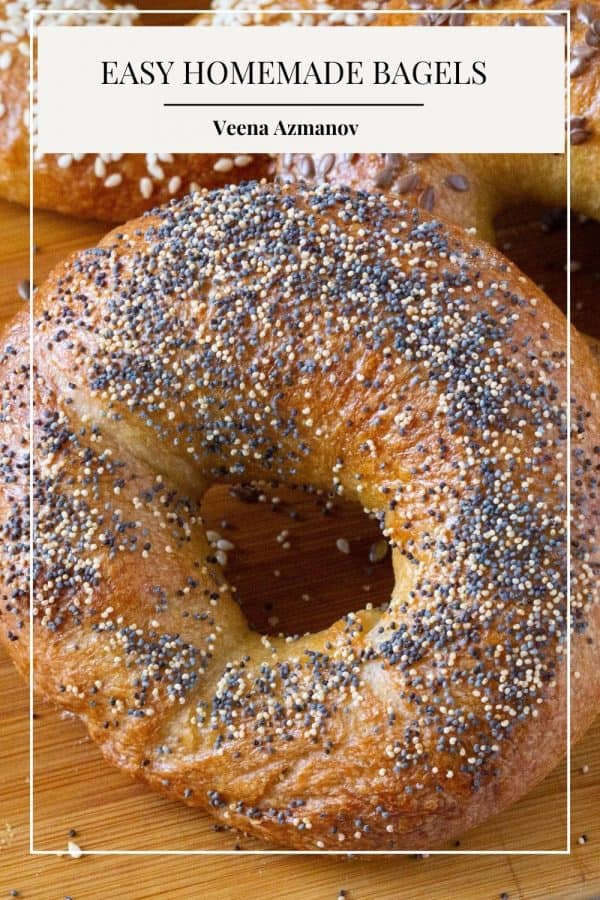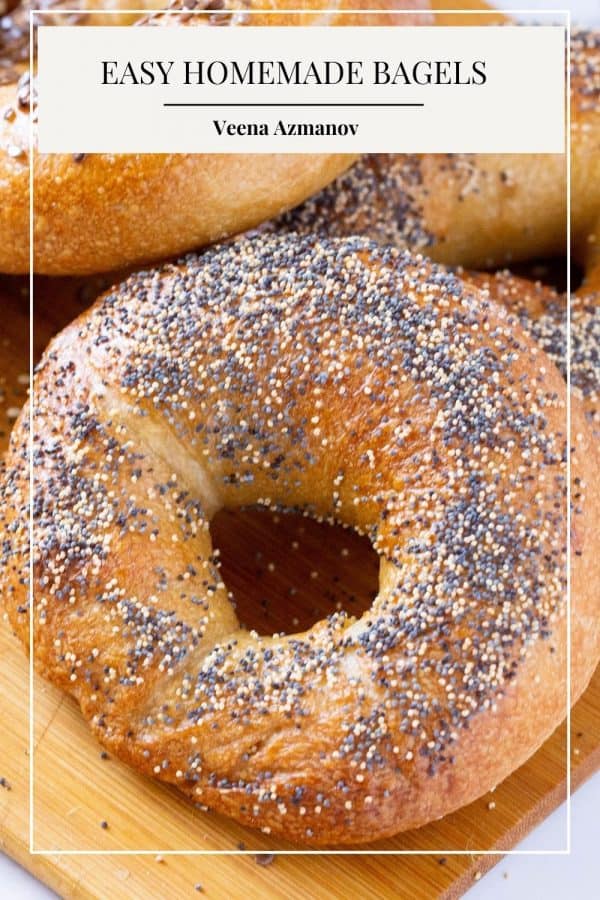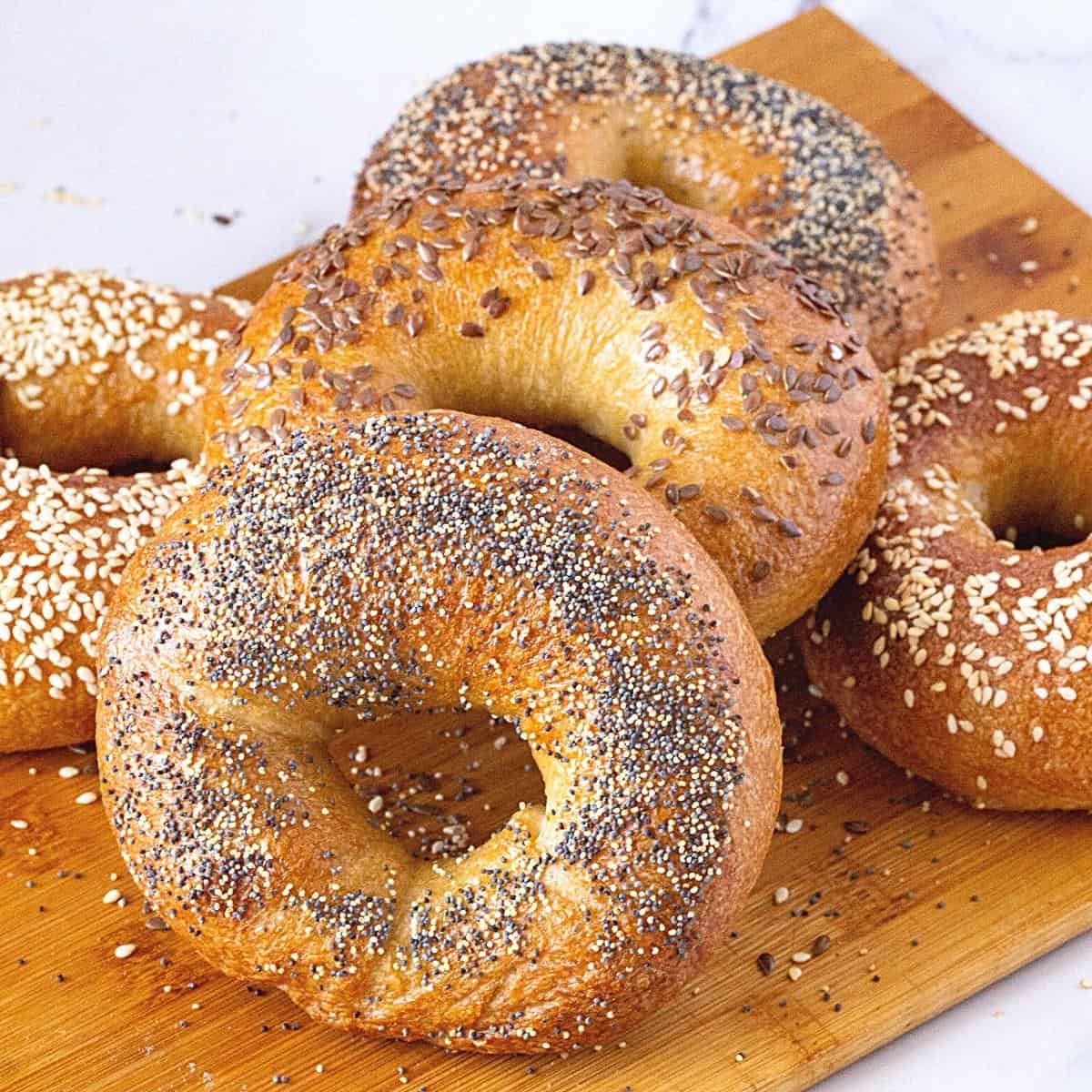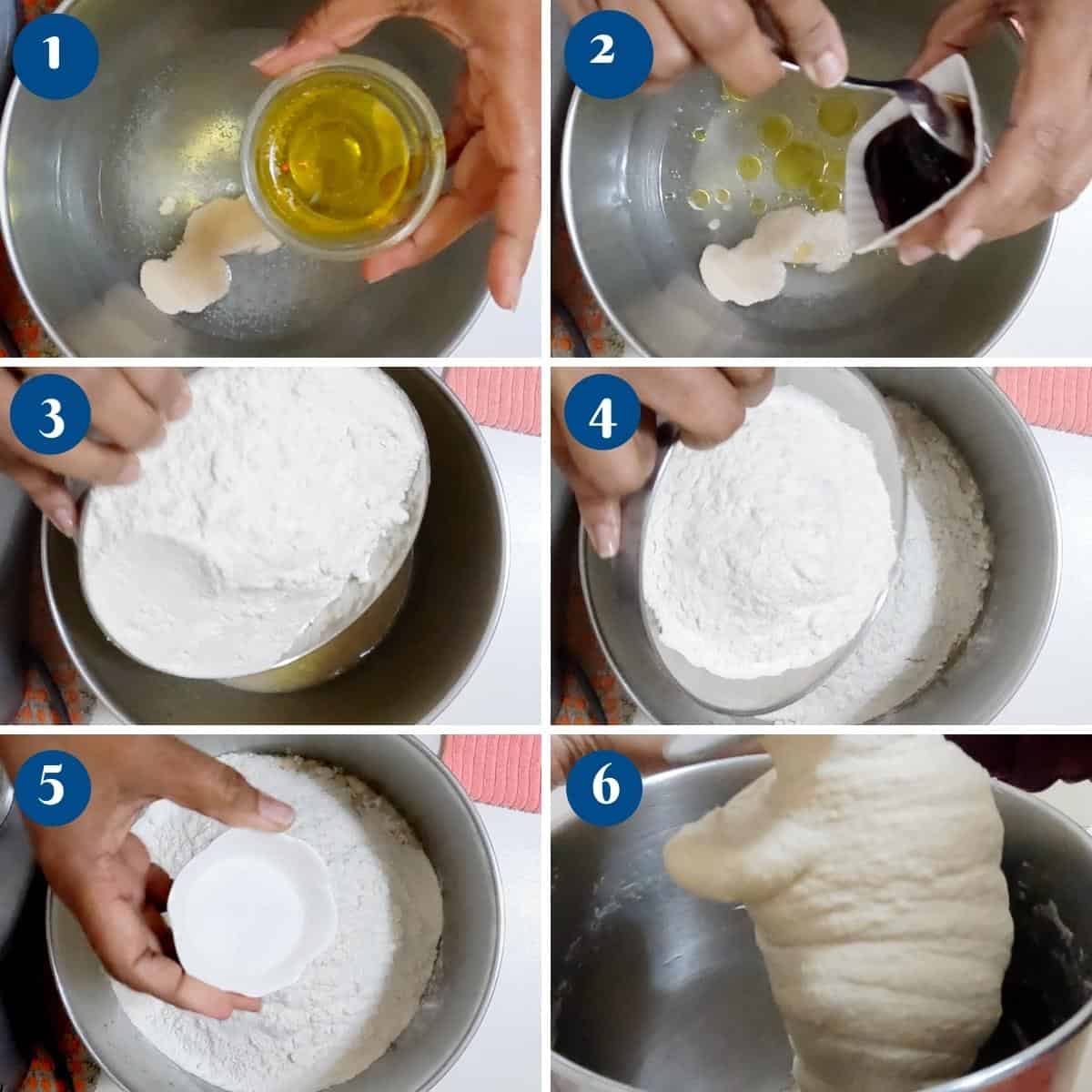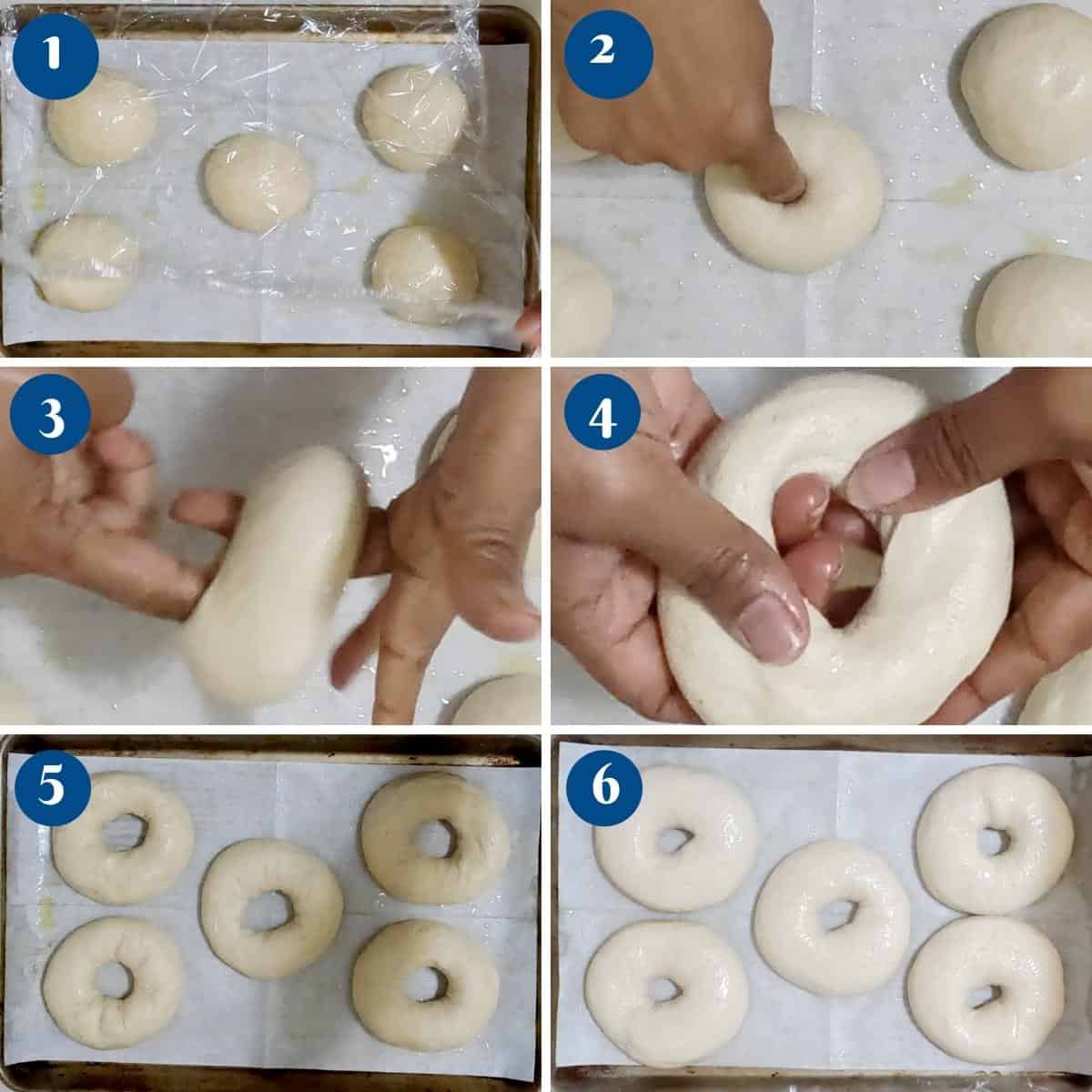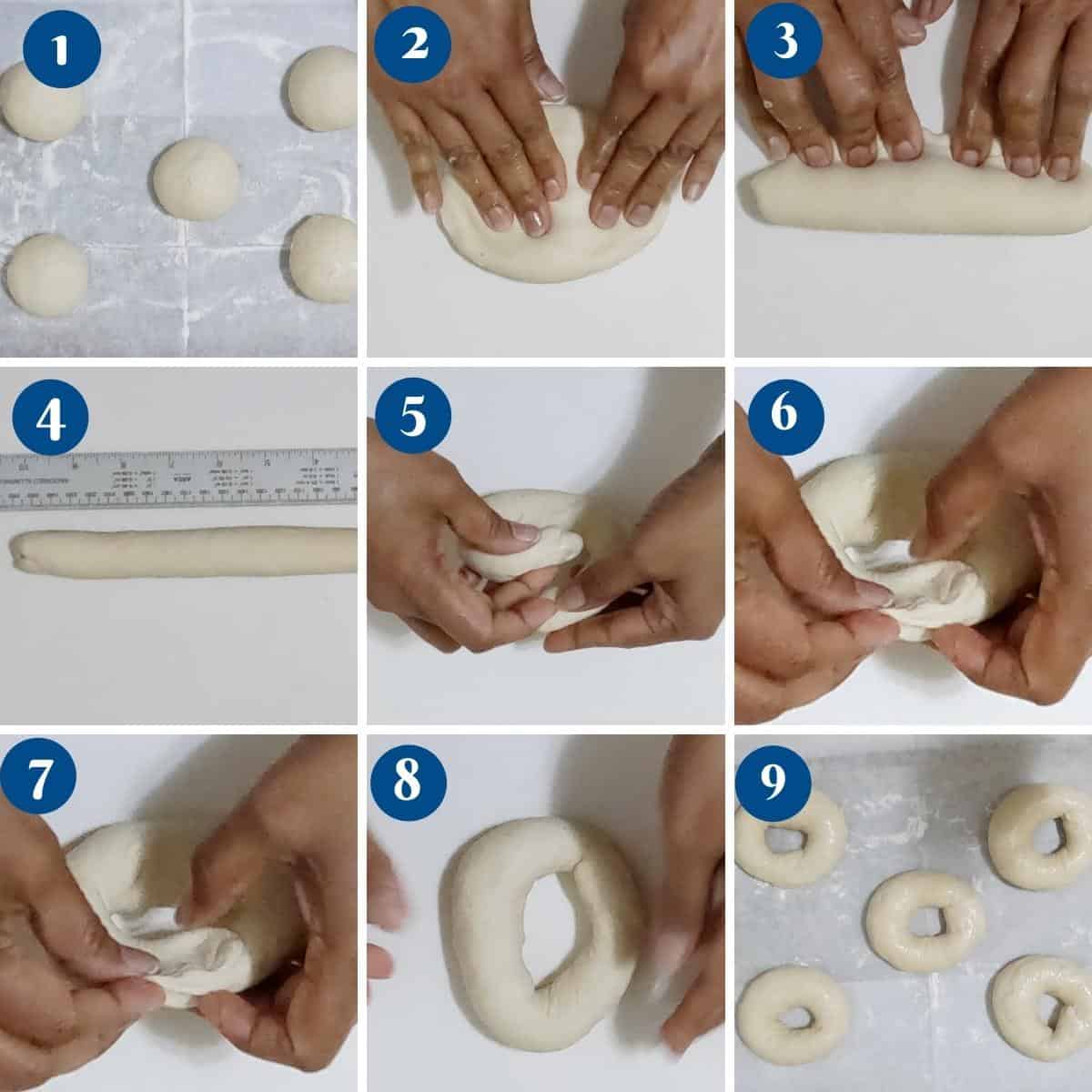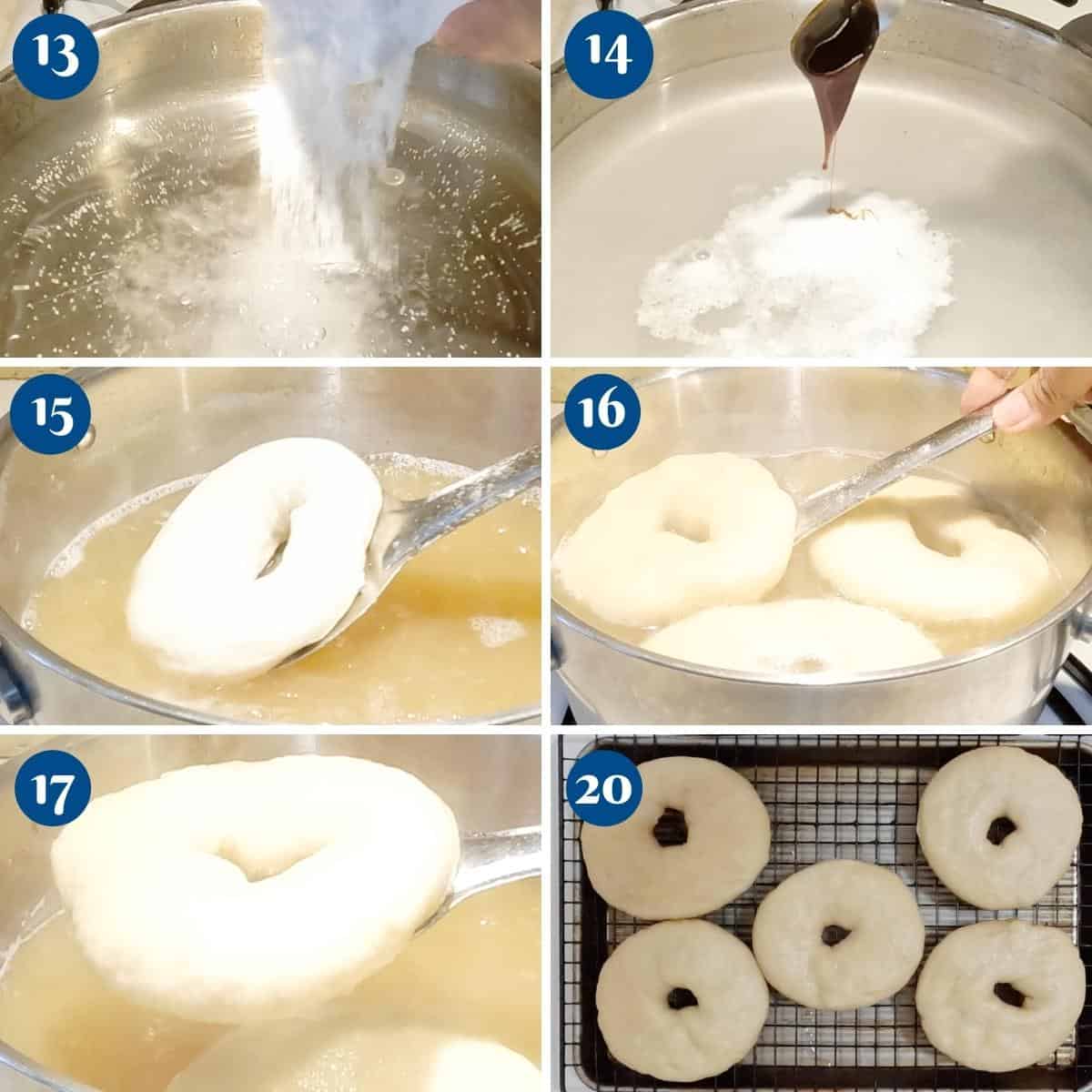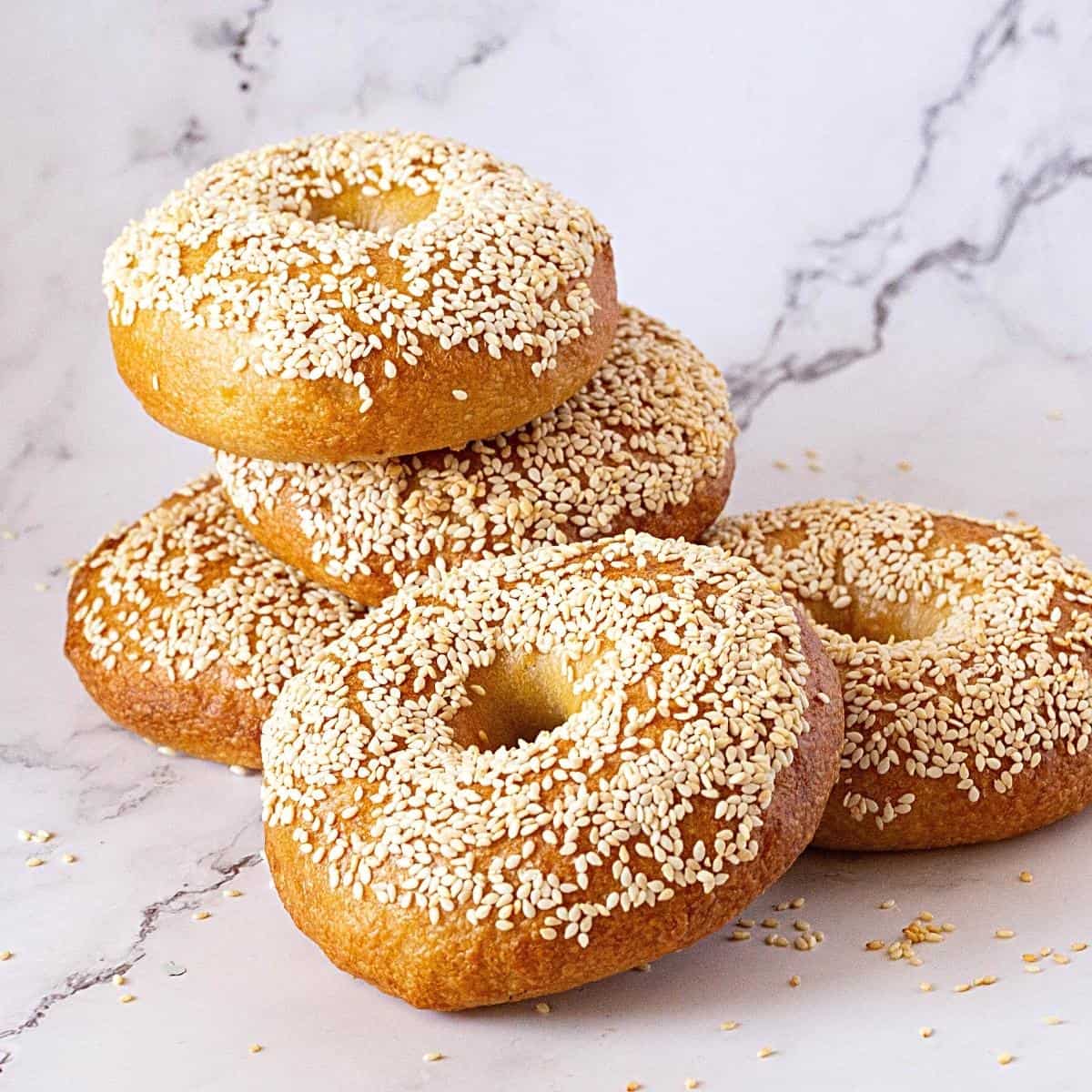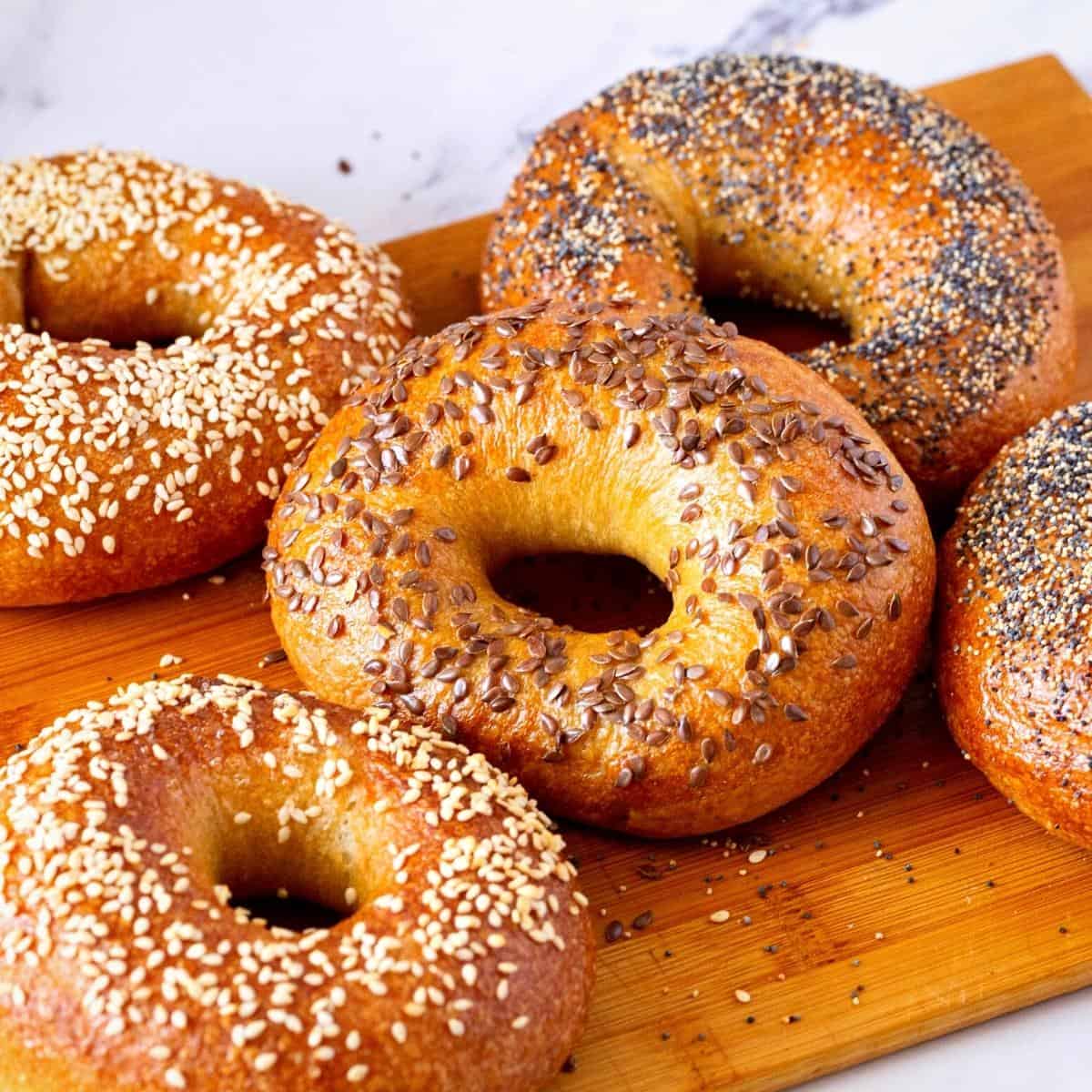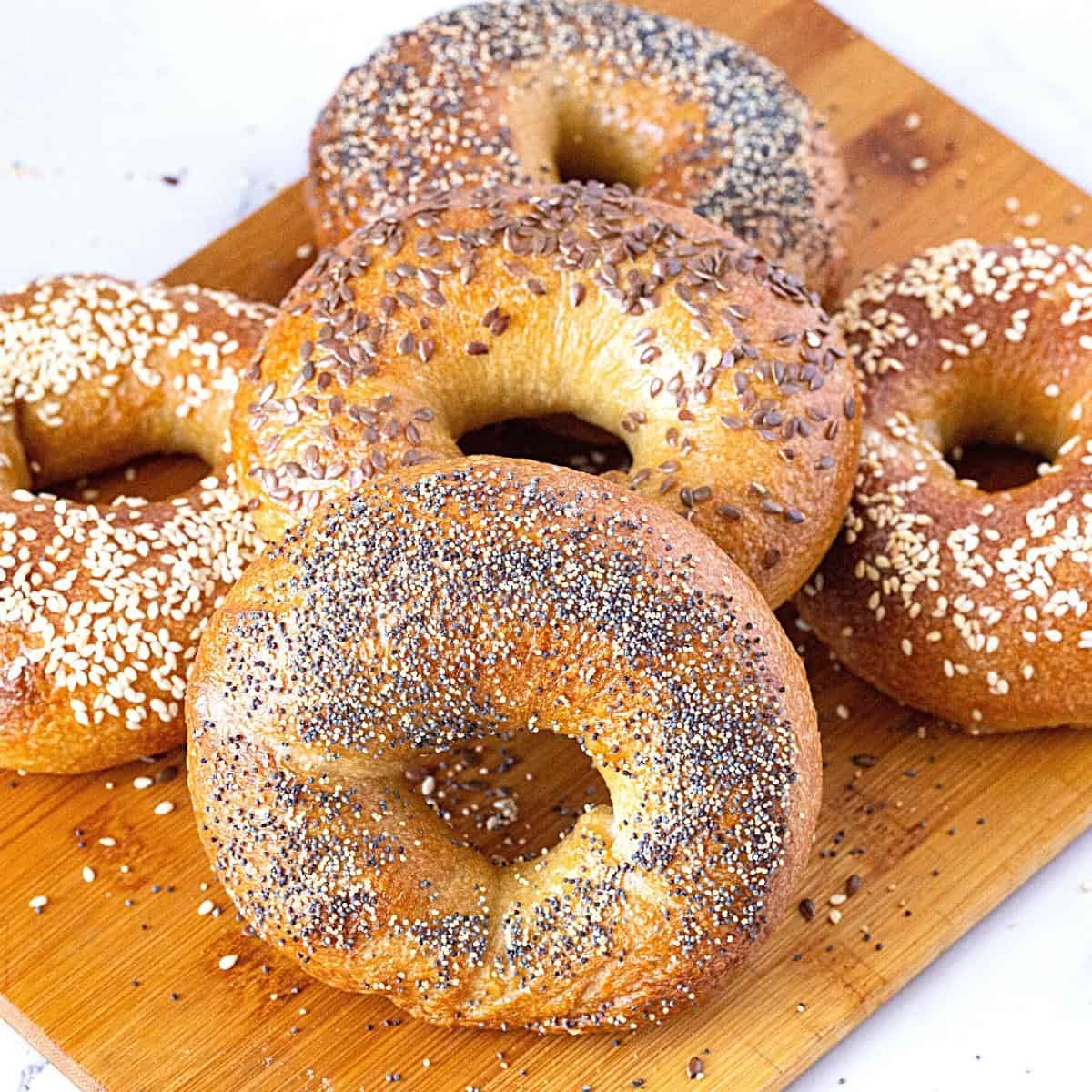One of my favorite things to do every time I visit New York is to eat a lox bagel sandwich. Having left the US for so many years, we do miss these things, especially Ziv. He lived in New York for many years. Although, we can find bagels locally, it still isn’t the same thing.
So, of course, I thought, how hard can it be? After all, its like baking bread. Well, turns out it’s not that simple to get the right texture, chewiness, and flavor. However, after a few attempts, I finally got it right. So, Mission accomplished.
Why make these bagels?
These New York-style homemade bagels are easy to make and don’t need any special equipment. They are soft and chewy, delicious on their own and perfect for any bagel sandwiches from breakfast to dinner. All the ingredients are easy to find or simple staples such as flour, yeast, sugar, oil, and water. And we do the classic poaching with baking soda, which gives us that thick chewy skin on the surface while still keeping that soft and light texture on the inside. These are delicious on their own but they also make perfect sandwiches.
Step-by-step: Homemade bagel recipe
Bagel dough
Combine – In the bowl of a stand mixer with the dough hook attachment, combine the warm water, yeast, oil, and barley malt syrup (or honey). Add the bread, all-purpose flour, and salt. Knead – Start the mixer at medium-high speed until all the flour is well incorporated. Then, continue to knead on medium speed for 8 to 10 minutes.Pro tip : transfer the dough to a well-dusted worktop and knead for 12 to 15 minutes.
Rest – When the dough is smooth, soft, and elastic shape it into a ball. Then, place the dough in an oiled bowl seam side down. And cover with a clean kitchen cloth or plastic wrap. Leave in a warm place. And let rise for 60 to 90 minutes until doubles in volumePro tip – In winter, you may need 90 minutes or more for the dough to rise. But, in summer the dough may double in 45 minutes. And if you can’t attend to it at that moment, de-gas and reshape the dough into a ball, then leave to double in volume again. Divide – When the dough is double in volume, transfer to a well-dusted floured surface. Punch it down and remove any air bubbles. Divide the dough into 2 portions, then each portion into 6. This makes 12 bagels of approximately 125 grams each.Pro-tip – At this point, there is no need for additional flour. So, use a light dusting of flour if necessary. Ball – Roll each piece of dough into a tight ball tucking all the seams under. Then, let the dough balls rest for 15 minutes.Pro trip – Resting the dough in between steps is crucial to help the gluten relax. Otherwise, stretching and shaping become a challenge.
Shape & proof
Method 1 – Using your fingers poke a hole in the center of each ball. Stretch it so the hole is at least 1 1/2 to 2-inches wide.Pro tip – Make sure the hole is big enough. Otherwise, it will close during proofing and baking.
Method 2 – Press the ball into a flat disc. Roll from one side to the other and roll to about 10 to 11 inches long rope. Then, flatten one side of the rope like a fan. Next, twist the rope, and then tuck the other side into the fan. Pinch the seams well.Pro tip – Do not use too much flour as it will prevent the dough from sticking together.
Method 3 – Press the ball into a flat disc. Roll from one side to the other and roll into a 10 to 11 inches long rope. Then, twist the rope and bring the two ends together and attach them. Next, put your hand through the hole in the center. And roll the dough back and forth on the unfloured work surface until the two ends are sealed together almost seamlessly.Pro tip – You can use a dab of water to pinch the two ends together, but too much water will prevent them from sticking.
Baking tray – Line two large baking trays with parchment paper. Spray the parchment with cooking spray or dust with flour. Then, place the bagel on the parchment leaving enough room for them to rise. Cover with plastic wrap or a clean kitchen towel and leave to rise for 60 to 90 minutes or until almost double in size.Pro tip – You can leave the bagels in the fridge overnight to slowly proof. Let them on the counter for 45 to 60 minutes before you poach them in a water bath. Proof Counter – Leave to rise on the counter at room temperature for 60 to 90 minutes or until almost doubled in size. Overnight – Alternatively, you can leave the bagels in the fridge overnight to slow proof. Then, take them out on the counter for 45 to 60 minutes before you poach them in a water bath.
Wath bath & bake
Preheat the oven to 390°F / 200°C/ Gas Mark 6 Poaching liquid – Bring a large pot of water to a boil. Add the salt, sugar, baking soda, and malt syrup.Pro tip – We need a wide, shallow pan so you can add 3 to 4 bagels at once. Otherwise, the water will be deep but not enough space for the bagels. Water bath – Once the water comes to a boil, carefully add the bagels a few at a time. Boil each bagel for 30-second on each side. Remove and place them back onto a baking tray lined with a wire rack to drain excess water.Pro tip – Overcrowding the pan will bring the temperature of the water down. And the longer you boil the bagels the thicker and chewier the crust will be.
Egg wash – Transfer the bagels back to the baking sheet lined with parchment paper or wipe excess moisture from the tray. Then, brush each bagel with beaten egg white or olive oil.Pro tip – Excess liquid in the baking tray will create steam during baking. This will make the crust harder. So, wipe excess liquid. Toppings – You can place the bagel upside down in the topping for a thicker coating. Or just sprinkle a few toppings on the bagel as shown in the video.Pro tip – I’ve used sesame seeds, poppy seeds, flax seeds, or everything bagel seasoning. You can also use other toppings like zaatar, fried onions, etc. Bake for 20 to 25 minutes until the top is golden brown. As soon as they come out of the oven, move them on the baking tray to prevent them from sticking.Pro tip – The egg whites and water can cause the bagel to stick to the parchment paper so move them on the tray while they are still hot. Cool – Let cool on the baking tray for 3 to 5 minutes. Then, transfer to a wire rack to cool further. Bagels are at their best the day they are baked. But, leftovers make great toast. And they also do keep well in the freezer.
Tips for success
Use bread flour – It gives a chewier bagel than all-purpose flour. The dough is very easy to knead by hand too. It must be soft and elastic. Use just enough flour necessary for kneading. And if you add too much flour it will be a very dense bagel. If you want the dough to rise quicker than 60 minutes – place the bowl in a warm oven with the light on. This usually takes only 30 to 45 minutes for me. And let the bagels proof for 45 to 60 minutes before you boil them in baking soda. These will ensure the inside is wonderfully light. Also, the poaching liquid must be boiling when you add the bagels. Adding salt to the baking soda helps it come to a rolling boil. The bagel must float on the water, not sink. If they sink, it means the water is not hot enough. It’s best to wait. Wipe all excess moisture from the baking pan. This moisture can create steam in the oven when baking. The steam causes the crust to become hard. We want a chewy, not hard crust. And brush the bagels with egg white – this will help the toppings stick. To make them egg-free brush with olive oil. Toppings – Avoid using onion flakes or garlic flakes as these tend to burn when baking. The granules work better. Alternatively, you can bake the bagels plain and then brush them with egg white and add the garlic/onion flakes at the final 2 minutes of baking. Browning – Too much or not enough. You can tent the bagels to prevent them from getting too brown. And if your bagels don’t get a brown color, it usually means the oven is not hot enough or there is uneven heating.
Troubleshooting
My bagels are flat, why? If you over boil the bagels in the boiling water, it can deflate the bagels losing all the air incorporated during the proofing. These will end up baking flat, hard, and dry. The bagel holes are closed, why? When shaping the bagels, make the holes about 1 1/2 to 2 inches. These will get smaller as they proof and bake. And if you make them too small, they will close when baking. Having said that, the holes do not affect the taste. They will still taste incredibly delicious. The bagels got stuck to the bottom of the pan? The water must be boiling. Do not add the bagels unless the water has come to a boil. When you add the bagel in, it must instantly float. This means the water is ready. If not, wait until the water is boiling. Covering the pot can help bring it up to a boil. The bagel toppings are burnt? Some toppings do well when baking some don’t. For example, seeds such as sesame, poppy, and salt do well. But, garlic and onion flakes tend to burn. Instead, use garlic and onions granules.
Homemade Everything Bagels Easy Homemade Pretzels, Soft whole wheat Pretzels Milk and Honey Challah Shokupan Sandwich Bread Homemade Soft Dinner Rolls Sourdough Loaf Bread See all Bread recipes
Frequently asked questions
Bagel variations
Plain bagels – Nothing inside, nothing outside. Trust me, these are delicious just on their own. Everything bagel – Is a seasoning blend made with white and black sesame seeds, garlic and onion granules, poppy seeds, and coarse salt. Sesame bagel – Topped with only sesame seeds! I like a combination of black and white sesame seeds. Garlic bagel – An absolute treat for garlic lovers. Add roasted garlic to the dough and top with garlic granules before baking. Montreal Bagel – Topped with sesame seeds and poppy seeds. New York- Style bagel – Topped with poppy seeds, sesame seeds, onion, and garlic granules. Asiago bagel – Sprinkle asiago cheese on top of the bagel and broil it until it melts. Onion bagel – Made with fresh garlic and sauteed onions in the bagel dough and dried garlic and sauteed onions as the topping. Pumpernickel bagel – A German variety of bagels usually made with sourdough starter and coarsely ground rye. You can also use rye flour with some molasses and caraway seeds. Cinnamon bagel – A slightly sweeter dough with cinnamon swirled into the dough. Raisin bagel – Incorporate soaked and rained golden and black raisin in the dough. Cinnamon raisin bagel – A slightly sweeter dough with the addition of soaked raisins and cinnamon swirled into the dough. Chocolate chip bagels – A slightly sweeter dough with chocolate chips added into the dough. Whole wheat bagel – Replace half the flour in this recipe with whole wheat flour. Pumpkin bagel – Replace some of the liquid in the recipe with pumpkin puree and pumpkin spice. This can be a sweet or savory bagel. Blueberry bagel – Incorporate fresh or soaked dried blueberries in the dough and top with a few dried blueberries before baking.
Bagel serving suggestions
Schmear bagels – Just a generous slathering of cream cheese, flavored or unflavored. Butter and jam or peanut butter and jelly! Nothing like the classic. Lox bagel sandwich – A generous spread of cream cheese topped with smoked salmon, some cucumbers tomatoes, and sliced onions. Bagel pastrami sandwich – This is very popular in our home. Similar to the lox sandwich, it’s made with a generous smear of cream cheese, tomato, cucumber, and pastrami or cold cuts. Avocado bagel sandwich – Slices of avocado with a sprinkle of salt, pepper, and lemon juice. You can also mash some boiled eggs with the avocado. Tuna bagel sandwiches – A wonderful combination of mayonnaise, canned tuna, parsley, and seasoning. French toast bagel – Perfect breakfast bagel to use leftovers or day-old bagels. Slice the bagels in half horizontally, and soak in French milk and egg custard. Then, toast them in a skillet with butter until golden.
Thank you for sharing - Save for later
